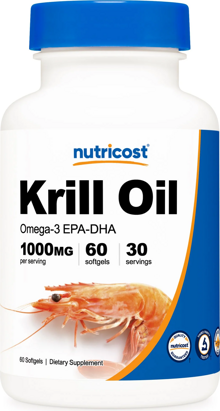
Nutricost Krill Oil
Go to Store| Serving Size: 2 Softgels | ||
| Servings Per Container: 30 | ||
| Amount Per Serving | % DV * | |
| Calories | 10 | |
| Total Fat | 1g | 1% |
| Superba2™ Krill Oil | 1,000mg | ** |
| Omega-3 Fatty Acids | 170mg | ** |
| EPA (eicosapentaenoic acid)(EE) | 110mg | ** |
| DHA (docosahexaenoic acid)(EE) | 60mg | ** |
| Phospholipids | 400mg | ** |
| Astaxanthin | 100mcg | ** |
|
* % Daily Value (DV) is based on a 2,000 calorie diet. Your daily values may be higher or lower based on your calorie needs.
† Daily Value (DV) not established. |
||

Nutricost Krill Oil
Go to StoreGET THE MOST OUT OF YOUR OMEGA’S
WITH HIGH QUALITY KRILL OIL
- Healthy Dose Of Omega-3’s
- Supports Immune System*
- High In Antioxidants
- Mercury Free
400MG
Phospholipids
220MG
Omega Fatty Acids
80MCG
Astaxanthin
SUPERIOR FISH OIL
Nutricost brings you a high quality and affordable Krill Oil supplement, designed to deliver potent omega-3’s and antioxidants. With 1000 mg per serving, each softgel provides Phospholipids, Omega-3 fatty acids, EPA, DHA, and Astaxanthin. Why take krill oil over fish oil competitors? Fish oil is weaker in antioxidant content, potentially contaminated from toxins, and susceptible to spoilage and oxidation.[1]
Unlike fish oil, krill oil carries omega-3’s in the form of phospholipids – a lipid compound that delivers the fatty acids directly to cells. These phospholipids are imperative because they provide the building blocks for cell membranes, regulate cellular transport, and help protect cell membranes from free radicals.[2] Phospholipids also greatly facilitate the passage of the fatty acid molecules through the intestinal wall making them more bioavailable, allows EPA and DHA to directly enter cells, and improves the omega-3 to omega-6 ratio.[3]
Astaxanthin is also an incredibly important component of krill oil, because unlike in fish oil, it protects the omega-3 fats along every stage of harvesting and processing to keep it from oxidizing. Astaxanthin (a carotenoid antioxidant) is produced by microalgae when water supply dries up, forcing it to protect itself from ultraviolet radiation by acting as a “force field” to protect from lack of nutrition or intense sunlight. This is the same mechanism that protects krill oil from oxidizing, which is critical since once a product oxidizes it becomes rancid, and may do more harm than good.[4]
Both Omega-3’s and Astaxanthin have a huge impact on the immune system, and potentially can reduce overall inflammation.* Astaxanthin has been shown to modulate immune response, inhibit cancer cell growth, reduce gastric inflammation, and protect against oxidative stress.[5] Dietary omega-3 fatty acids have a variety of anti-inflammatory and immune-modulating effects as well, and the particular fatty acids that appear to be most potent are the long-chain polyunsaturates derived from marine oils, namely eicosapentaenoic acid (EPA) and docosahexaenoic acid (DHA).[6]
References [+]
References [-]
- [1] Ulven, Stine M., et al. Metabolic effects of krill oil are essentially similar to those of fish oil but at lower dose of EPA and DHA, in healthy volunteers.Lipids 46.1 (2011): 37-46. Retrieved on 10 Feb 2017.
- [2] Van Meer, Gerrit, Dennis R. Voelker, and Gerald W. Feigenson. Membrane lipids: where they are and how they behave.Nature reviews Molecular cell biology 9.2 (2008): 112-124. Retrieved on 10 Feb 2017.
- [3] Schuchardt, Jan Philipp, et al. Incorporation of EPA and DHA into plasma phospholipids in response to different omega-3 fatty acid formulations-a comparative bioavailability study of fish oil vs. krill oil.Lipids in health and disease 10.1 (2011): 145. Retrieved on 10 Feb 2017.
- [4] Bays, Harold E. Safety considerations with omega-3 fatty acid therapy.The American journal of cardiology 99.6 (2007): S35-S43. Retrieved on 10 Feb 2017.
- [5] Park, Jean Soon, et al. Astaxanthin decreased oxidative stress and inflammation and enhanced immune response in humans.Nutrition & metabolism 7.1 (2010): 18. Retrieved on 10 Feb 2017.
- [6] Mori, Trevor A., and Lawrence J. Beilin. Omega-3 fatty acids and inflammation.Current atherosclerosis reports 6.6 (2004): 461-467. Retrieved on 10 Feb 2017.
* RESULTS MAY VARY




